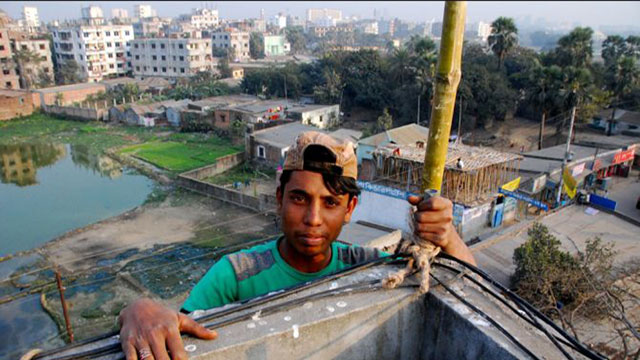Featured Projects

On 08, Sep 2010 | In Multi-Platform Storytelling Video Production | By erikgerman
Dhaka: Life inside the world’s fastest growing megacity
For GlobalPost
An in-depth report on the forces driving urbanization from inside the slums of Earth’s fastest-growing megacity. Working alongside my wife, Solana Pyne, I co-produced, shot and wrote this multi-platform project in Dhaka, Bangladesh for GlobalPost. The project ran on PBS Newshour, was a Livingston Award finalist and won three 2010 SABEW “Best in Business” awards.
Here’s the video:
Here’s an excerpt:
DHAKA, Bangladesh — The future is here, and it smells like burning trash.
As the evening call to prayer echoes across Dhaka’s teeming slums, a bluish haze rises in the murky air. Cooking happens mostly on open fires in the shantytowns of the Bangladeshi capital, the flames kindled with paper, scavenged lumber and bits of plastic junk.
On a recent evening in a broken labyrinth of shacks called the Korail slum, a wiry young mother in a red sari stooped to light the clay hearth outside her family’s one-room home. Mina, 24, touched her match to a castoff vinyl folder, three-hole-punched for documents she’ll never read.
“I don’t like to live in Dhaka,” she said, fanning the smoking plastic, then laying splintered bamboo on top. “But we have a dream to buy a piece of land, some land back in our village.”
Mina, who uses only one name, followed her husband here in 2009 — joining the nearly half-million migrants who pour into Dhaka each year. It’s not clear how soon, if ever, they’ll leave. Mina’s husband saves only a few dollars each month from his job selling fish. Mina, meanwhile, cares for their two children and, like millions of other women here, fires up the family’s nightly meal.
The smoke from these fires signals not a return to a prior age but, rather, the dawn of something new. Depending on how one measures, the planet now boasts 20 or so megacities — urban agglomerations where the United Nations estimates the population has reached 10 million or more. The world’s rapid urbanization is a reality fraught with both peril and hope. The peril is obvious. Overcrowding, pollution, poverty, impossible demands for energy and water all result in an overwhelming sense these megacities will simply collapse. But the hope, while less obvious, needs more attention. The potential efficiencies of urban living, the access to health care and jobs, along with plummeting urban birth rates have all convinced some environmental theorists the migration to cities may in fact save the planet. But only, these experts hasten to add, if this shift is well managed.
Read the full story, see photos and watch videos on Global Post:
Part I: Dhaka: World’s Fastest Growing Megacity — A five-part, multimedia series on the coming dystopia that is urbanization.
Part II: The dreams of Dhaka’s garment girls — 80 percent of the garment industry’s 3 million workers in Bangladesh are women.
Part III: Disasters drive mass migration to Dhaka — When describing why they came, migrants tell stories of flood and famine.
Part IV: The bright side of Earth’s growing slums — Biologist Stewart Brand argues that megacity slums are a boon for planet Earth.
Part V: Who can solve a problem like Dhaka? — The population of Bangladesh’s capital is expected to hit 20 million by 2025.







